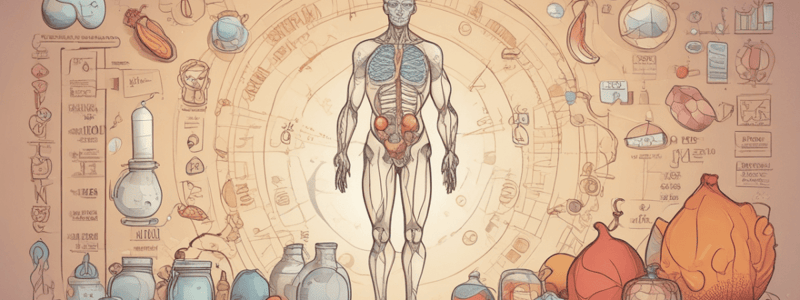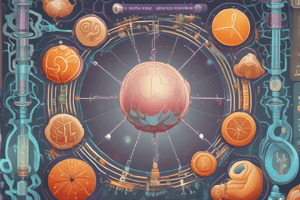Podcast
Questions and Answers
Where is the active site of glucose-6-phosphatase enzyme located?
Where is the active site of glucose-6-phosphatase enzyme located?
- Golgi apparatus
- ER lumen (correct)
- Mitochondria
- Cytosol
Fast-twitch muscle fibers use aerobic glycolysis for metabolism.
Fast-twitch muscle fibers use aerobic glycolysis for metabolism.
False (B)
What is the last source of material for gluconeogenesis?
What is the last source of material for gluconeogenesis?
muscle protein (after glycogen and fat)
Lactate is transferred by _______________________ cells.
Lactate is transferred by _______________________ cells.
Match the sources of lactate with their descriptions:
Match the sources of lactate with their descriptions:
What is the purpose of gluconeogenesis?
What is the purpose of gluconeogenesis?
Cori Cycle involves the synthesis of glucose from lactate.
Cori Cycle involves the synthesis of glucose from lactate.
An important function of glucose-6-phosphatase enzyme is to regulate _______________________ levels.
An important function of glucose-6-phosphatase enzyme is to regulate _______________________ levels.
What is the end result of carbohydrate digestion?
What is the end result of carbohydrate digestion?
Glycolysis is an anabolic pathway.
Glycolysis is an anabolic pathway.
What is the standard free energy change associated with the complete oxidation of glucose to CO2 and H2O?
What is the standard free energy change associated with the complete oxidation of glucose to CO2 and H2O?
Glycolysis is a series of __________ enzyme-catalyzed reactions.
Glycolysis is a series of __________ enzyme-catalyzed reactions.
Match the following metabolic pathways with their respective functions:
Match the following metabolic pathways with their respective functions:
What is the fate of non-digestible carbohydrates, such as cellulose?
What is the fate of non-digestible carbohydrates, such as cellulose?
What type of reaction occurs during the breakdown of glycogen?
What type of reaction occurs during the breakdown of glycogen?
The breakdown of glycogen releases glucose-1-phosphate.
The breakdown of glycogen releases glucose-1-phosphate.
What is the function of glycogen phosphorylase in the breakdown of glycogen?
What is the function of glycogen phosphorylase in the breakdown of glycogen?
Glycogen is a type of _______________ storing glucose molecules.
Glycogen is a type of _______________ storing glucose molecules.
What is the result of the phosphorolytic breakdown of glycogen?
What is the result of the phosphorolytic breakdown of glycogen?
Glycogen phosphorylase is an enzyme that catalyzes the hydrolytic breakdown of glycogen.
Glycogen phosphorylase is an enzyme that catalyzes the hydrolytic breakdown of glycogen.
What is the significance of the nonreducing end of a glycogen molecule?
What is the significance of the nonreducing end of a glycogen molecule?
Match the following enzyme with its function:
Match the following enzyme with its function:
Flashcards are hidden until you start studying
Study Notes
Breakdown of Glycogen to Supply Glucose
- Glycogen is a homopolymer of glucose stored in the liver and muscles
- Glycogen phosphorylase catalyzes the breakdown of glycogen into glucose 1-phosphate through a phosphorolysis reaction
- The reaction involves the attack of inorganic phosphate on the terminal glucosyl residue at the non-reducing end of a glycogen molecule
- Glucose 1-phosphate is released, and the glycogen molecule is shortened by one glucose residue
Regulation of Glycolysis and Gluconeogenesis
- The pathway of glycolysis and gluconeogenesis is regulated to maintain blood sugar levels within an acceptable range
- The Cori Cycle plays a key role in this regulation by synthesizing glucose from lactate
- Lactate is sourced from fast-twitch muscle fibers and red blood cells
- Gluconeogenesis from amino acids involves protein mobilization, with muscle protein being the last source of material for gluconeogenesis
Digestion of Carbohydrates
- Carbohydrates must be broken down into monosaccharides to be absorbed through the intestine wall and into the bloodstream
- Monosaccharides are transported into cells by passive diffusion through transmembrane proteins
- Non-digestible carbohydrates, such as cellulose, are not absorbed and end up in feces
Major Pathways of Glucose Utilization
- Glycolysis, gluconeogenesis, and the pentose phosphate pathway are major pathways of glucose utilization
- Glycolysis and catabolism involve the breakdown of glucose, while gluconeogenesis and anabolism involve the synthesis of glucose
- Glycolysis yields ATP, NADH, and pyruvate as products
What is Glycolysis?
- Glycolysis is a series of ten enzyme-catalyzed reactions that degrade glucose into pyruvate
- Glucose is the major fuel of most organisms and is rich in potential energy
- The complete oxidation of glucose to CO2 and H2O proceeds with a standard free energy change of -2,840 kJ/mol
Studying That Suits You
Use AI to generate personalized quizzes and flashcards to suit your learning preferences.




